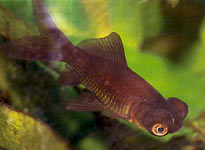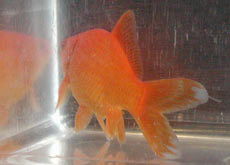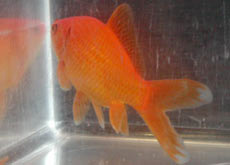London shubunkin























| Home | Goldfish Types | Goldfish Info |
Note: This website is a direct descendant of the Bristol Aquarists' Society (BAS) website, which closed in December 2024 (more info).
Featured here are the principle varieties of fancy goldfish as bred by BAS and other UK goldfish societies. Click on the image of each fish to learn more about the type.
A word about terminology! There is in fact only one goldfish species, and the many fancy goldfish varieties or breeds all belong to this same species. Within each variety, however, there may be many different strains; thus, for example, a breeder of veiltails will over time develop his/her own strain of veiltail, differing slightly in colour, finnage, body shape and genetic background from other breeders' strains of veiltail. This is clearly seen when you go to a major goldfish show and see the different strains of veiltail side by side on the show bench; but they are all veiltails compared, say, with fantails, comets or other varieties.
And a word about the abbreviations for the shows from which the photographs were taken: BAS is short for the Bristol Aquarists' Society shows, and GSGB is short for the Goldfish Society of Great Britain shows.
For background information about goldfish - their history, colour and finnage, and a glossary of terms used in describing goldfish, see Goldfish Info.
All the goldfish varieties originate from China (including the ranchu and the ryukin, which many these days associate more with Japan), except for:
| Type | Description | Found in | |||
| UK | Far East | USA | |||
| Long Bodied: fish with the natural, wild-type body length | |||||
| Single Tailed: fish with the natural, wild-type tail or an elongated or enlarged tail | |||||
| Common Goldfish & London shubunkin |
Wild-type body form and finnage, metallic or calico colouration | Common | Common | Common |  |
| Comet | Slim-bodied with long and sharply pointed finnage, colouration mostly metallic | Common | Common | Common |  |
| Bristol shubunkin |
Wild-type body form with a large, heart-shaped tail, calico colouration only | Uncommon | Rare | Rare |  |
| Double Tailed: fish in which the two layers of the natural tail (which is a laminate of two layers) have divided and grow separately | |||||
| Wakin | Slightly shorter body than wild-type with a double, fantail-like tail, metallic colouration only | Rare | Common | Less common |  |
| Jikin or peacock-tail | Slightly shorter body, divided tail which is splayed outwards | Rare | Uncommon | Less common |  |
| Short Bodied: shortened body length, double tail and double (divided) anal fin | |||||
| Long Tailed (Veiltailed): fish with deep bodies, a high dorsal fin and a long, flowing double tail in which the fork has largely been bred out | |||||
| Veiltail | Very round-bodied with a long, flowing "veil" tail, colour metallic or calico | Uncommon | Rare | Uncommon |  |
| Oranda | Basic veiltail with raspberry-like growth on the head called a hood | Less common | Far Eastern type common | Common |  |
| Redcap Oranda | White-bodied oranda with hood growth confined to a red cap on top of the head | Less common | Common | Less common |  |
| Broadtail Moor | Basic veiltail with eyes protruding from the head in a telescopic manner, colour deep velvety black | Uncommon | Far Eastern type common | Common |  |
| Globe Eye | Similar to the moor, colour metallic or calico, tail usually slightly forked | Uncommon | Far Eastern type common | Uncommon |  |
| Short Tailed (Fantailed) WITH Dorsal Fin: fish with oval (egg-shaped) bodies, short finnage and a well forked double tail held out like a fan | |||||
| Fantail | Colour mainly red or calico | Less common | Far Eastern type common | Common |  |
| Pearlscale | Scales raised in the shape of pearls, body shape approaching a sphere | Less common | Common | Common |  |
| Short Tailed (Fantailed) WITHOUT Dorsal Fin: as above but with a smooth dorsal contour and no dorsal fin | |||||
| Eggfish | Short, rounded fins; phoenix eggfish has long, flowing finnage | Rare | Uncommon | Rare |  |
| Lionhead | Raspberry-like hood growth on the head; mostly red or calico | Less common | Common | Less common |  |
| Ranchu | Similar to lionhead but with much more curved posterior dorsal contour | Uncommon | Common | Common |  |
| Celestial | Protruding, upturned eyes; metallic or calico | Uncommon | Less common | Uncommon |  |
| Pompon | Large, frilly nasal septa; metallic or calico | Rare | Uncommon | Uncommon |  |
| Bubble Eye | Large bubble-like eye sacs; metallic or calico | Less common | Common | Common |  |
| Other Twin Tailed: short-bodied, double-tailed types that do not fit into the above scheme (i.e. that are neither Veiltails nor Fantails) | |||||
| Ryukin | Intermediate between fantail and veiltail with deep body, tail of varying length, pointed head and dorsal hump | Uncommon | Common | Common |  |
| Tosakin | Similar to fantail except for the partially divided double tail which is splayed sideways and forwards | Rare | Uncommon | Rare |  |
| Butterfly | Similar to fantail with globe eyes and a divided double tail which is splayed sideways and forwards | Uncommon | Less common | Uncommon |  |
| Oriental twintail (man-yu) | Intermediate between Fantail and Ryukin, smooth dorsal contour and fairly long, drooping, forked tail | Common | Common | Common |  |
| Experimental Varieties | |||||
| Imperial | Red metallic single-tailed fish intermediate between Bristol shubunkin and veiltail in appearance | Extremely rare, limited to participating breeders in the London area | Absent | Absent |  |
The Nationwide Goldfish Societies UK has published videos of the Nationwide annual shows in 2018 and 2019, illustrating the different goldfish varieties.
There are some 20 varieties of goldfish described above, with variations between the Far Eastern and the Western versions adding to the count. In fact, in China there are considered to be about 300 varieties, encompassing nearly the full range of permutations in the following features:
You will find the main variations described on each of the individual pages accessed from the table above. To the British, many of the Chinese types are hybrid varieties, but that is just one of several valid viewpoints. There is, however, a commercial dimension to developing new varieties, and some of these, for example the black and white fish, can be spectacular; others are not to the Western taste, for example:
In Britain, goldfish breeders like to maintain the recognized varieties distinct from each other, and little merit is seen in blending the different strains. Further, fish shows are competitive, and the exhibitors are very keen hobbyists; individual fish of a given variety manifesting characters that 'rightly' belong to another variety do not fare well in competition.
An example of a hybrid or 'sport' is this globe eyed common goldfish. The globe eye feature was first observed about 400 years ago (see History), and sometimes appears where least expected; shown below is a globe eyed young common goldfish, found amongst ordinary common goldfish that had been left to breed naturally in a pond in Exeter, Devon. (Picture by Catherine Howard, courtesy of Aquarist and Pondkeeper, 2002).

Below is another sport seen at BAS 2004, a common goldfish with a double anal fin. (This feature was first recorded 100-200 years earlier than the globe eye). Notice also the longer tail lobes than per the standard for the common goldfish.
 |
 |